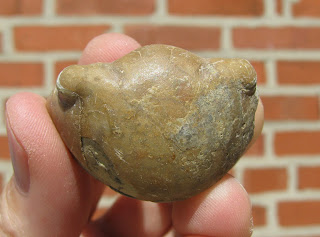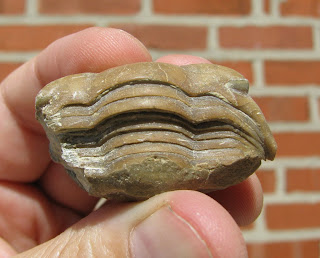I'm winding down on my Ordovician fossils from Russia. Today we have some partial trilobites from the Ordovician aged rocks near St. Petersburg, Russia.
First up are three partial specimens of Lonchodomas volborthi from the middle Ordovician (Dapingian stage of the ICS, Volkhovian stage locally) of Putilovo quarry, St. Peterburg region, Russia. Two are thorax and pygidium specimens:
The third is a partial cephalon that is missing it's spines. There should be one on the tip of the glabella and one each coming off the side of the cephalon. I am very interested in the fact that there are two differently colored areas on the sides of the glabella that are mirror images of each other. It seems that this is not uncommon for this genus from this location either as evidenced by specimens that are posted on the PaleoArt.com (Saint Petersburg Paleontological Laboratory) website.
The chunk of rock that the cephalon is on has quite a few Ostracods preserved in it as well.
The second trilobite I have to show today is Illaenus sp.
(Dapingian stage of the ICS, Kunda stage locally). I don't know the exact location for this specimen as it came mislabeled as Asaphus lepidurus. It is not in the best shape but I received it as part of a trade so it will have a place in my collection until I can afford a better specimen.
There are 30 different species for this genus listed on the Baltoscandian Fossils website here, so I don't know if I will ever be able to nail down the species on my specimen. Looking at the first picture of this specimen reminds me of the Thaleops cephalon I found in the Verulam fm. in Canada.
















who discovered the first fossil?
ReplyDelete